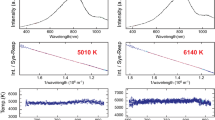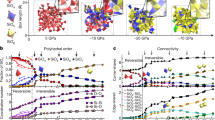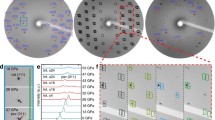Abstract
Single-crystal X-ray diffraction experiments with SiO2 α-cristobalite reveal that the well-known reversible displacive phase transition to cristobalite-II, which occurs at approximately 1.8 GPa, can be suppressed by rapid pressure increase, leading to an overpressurized metastable state, persisting to pressure as high as 10 GPa. In another, slow pressure increase experiment, the monoclinic high-pressure phase-II was observed to form at ~1.8 GPa, in agreement with earlier in situ studies, and its crystal structure has been unambiguously determined. Single-crystal data have been used to refine the structure models of both phases over the range of pressure up to the threshold of formation of cristobalite X-I at ~12 GPa, providing important constraints on the feasibility of the two competing silica densification models proposed in the literature, based on quantum mechanical calculations. Preliminary diffraction data obtained for cristobalite X-I reveal a monoclinic unit cell that contradicts the currently assumed model.











Similar content being viewed by others
Notes
It should be noted that at least at ambient pressure only the high-temperature β-cristobalite is a stable phase according to the thermodynamic definition. All other cristobalite phases are metastable. Throughout this paper, we use the term “metastable overpressurization” to describe the phenomenon of suppression of a displacive phase transition from one metastable phase to another that would otherwise occur on compression at ambient temperature.
References
Brandenburg K, Putz H (2009) Endeavour. Crystal Impact GbR, Bonn
Dera P (2007) GSE_ADA data analysis program for monochromatic single crystal diffraction with area detector. GSECARS, Chicago
Dewaele A, Datchi F et al (2008) High pressure-high temperature equations of state of neon and diamond. Phys Rev B77:094106
Dmitriev V, Torgashev V et al (1997) Theory of SiO2 polymorphs. Europhys Lett 37:553–558
Donadio D, Martonak R et al (2008) Influence of temperature and anisotropic pressure on the phase transition in a-cristobalite. Phys Rev Lett 100:165502
Dove MT, Craig MS et al (2000) Crystal structure of the high-pressure monoclinic phase-II of cristobalite, SiO2. Mineral Mag 64:569–576
Downs RT, Palmer DC (1994) The pressure behavior of a cristobalite. Am Mineral 79:9–14
Downs RT, Gibbs GV et al (1990) A study of the mean-square displacement amplitudes of Si, Al and O atoms in framework structures: evidence for rigid bonds, order, twinning and stacking faults. Am Mineral 75:1253–1267
Dubrovinsky LS, Dubrovinskaia NA et al (2004) A class of new high-pressure silica polymorphs. Phys Earth Planet Inter 143–144:231–240
Durandurdu M (2009) Formation of an anataselike phase in silica under anisotropic stress: an ab initio constant-pressure study. Phys Rev B 80:024102
Farrow CL, Juhas P et al (2007) PDFfit2 and PDFgui: computer programs for studying nanostructure in crystals. J Phys Condens Matter 19:335219
Garg N, Sharma SM (2007) Classical molecular dynamical simulations of high-pressure behavior of alpha cristobalite (SiO2). J Phys Condens Matter 19:456201
Huang L, Durandurdu M et al (2006) Transformation pathways of silica under high pressure. Nat Mater 5:977–981
Keskar NR, Chelikowsky JR (1992) Structural properties of nine silica polymorphs. Phys Rev B46:1–13
Klotz S, Chervin J-C et al (2009) Hydrostatic limits of 11 pressure transmitting media. J Phys D Appl Phys 42:075413
Liang Y, Miranda CR et al (2007) Tuning oxygen packing in silica by nonhydrostatic pressure. Phys Rev Lett 99:215504
Mao HK, Xu J et al (1986) Calibration of the ruby pressure gauge to 800 kbar under quasi-hydrostatic conditions. J Geophys Res 91:4673–4676
Onodera A, Suito K et al (1997) Synchroteon X-ray diffraction study of cristobalite at high pressure and high temperature. High Pressure Res 15:307–319
Palmer DC, Finger LW (1994) Pressure-induced phase transition in cristobalite: an X-ray powder diffraction study to 4.4 GPa. Amer Mineral 79:1–8
Palmer DC, Hemley RJ et al (1994) Raman spectroscopic study of high-pressure phase transitions in cristobalite. Phys Chem Mineral 21:481–488
Putz H, Schon JC et al (1999) Combined method for ‘Ab Initio’ structure solution from powder diffraction data. J Appl Cryst 32:864–870
Rivers ML, Prakapenka VB et al (2008) The COMPRES/GSECARS gas loading system for diamond anvil cells at the advanced photon source. High Pressure Res 28:273–292
Sheldrick GM (2008) A short history of SHELX. Acta Cryst A64:112–122
Sowa H (1988) The O packings of low-quartz and ReO3 under high pressure. Zeit Krist 184:257–268
Thompson RM, Downs RT (2010) Packing systematics of the silica polymorphs: the role played by O–O nonbonded interactions in the compression of quartz. Am Mineral 95:104–111
Tsenyuki S, Matsui Y et al (1989) New pressure-induced structural transformations in silica obtained by computer simulation. Nature 339:209–211
Van Valkenburg A, Buie BF (1945) Octahedral cristobalite with quartz paramorphs from Ellora Caves, Hyderabad State, India. Am Mineral 30:526–535
Yahagi Y, Yagi T et al (1994) Infrared absorption spectra of the high-pressure phases of cristobalite and their coordination numbers of silicon atoms. Solid State Comm 89:945–948
Acknowledgments
We would like to thank the anonymous reviewers for useful suggestions that helped to improve the manuscript. This work was performed at GeoSoilEnviroCARS (Sector 13), Advanced Photon Source (APS), Argonne National Laboratory. GeoSoilEnviroCARS is supported by the National Science Foundation–Earth Sciences (EAR-0622171) and Department of Energy–Geosciences (DE-FG02-94ER14466). Use of the Advanced Photon Source was supported by the U. S. Department of Energy, Office of Science, Office of Basic Energy Sciences, under Contract No. DE-AC02-06CH11357. Funding for MB and RTD was provided by the CDAC program.
Author information
Authors and Affiliations
Corresponding author
Rights and permissions
About this article
Cite this article
Dera, P., Lazarz, J.D., Prakapenka, V.B. et al. New insights into the high-pressure polymorphism of SiO2 cristobalite. Phys Chem Minerals 38, 517–529 (2011). https://doi.org/10.1007/s00269-011-0424-5
Received:
Accepted:
Published:
Issue Date:
DOI: https://doi.org/10.1007/s00269-011-0424-5




